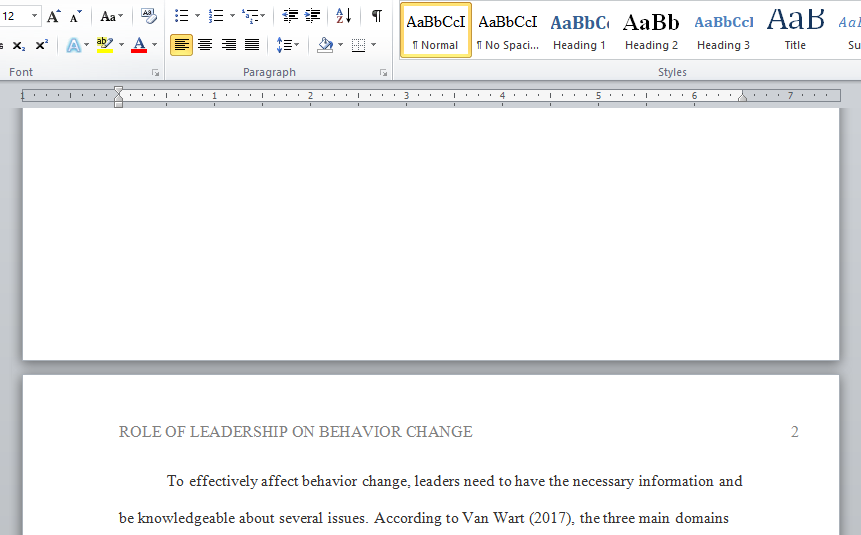How do leaders change behaviors?
Leaders can change behaviors, according to Van Wart, by using conflict management, which he refers to as reactive, proactive and creative aspects. He also states that there are guidelines that leaders should use to help minimize resistance to change. He states that leaders can generate a sense of importance or urgency about the need for change, seek common ground for genuine compromise, create an environment that reduces dysfunctional conflicts, and utilize the positive aspect of conflicts that allow different opinions and ideas to be embraced. Although, all behaviors cannot be successfully addressed, dealing with issues and concerns before they exacerbate can help curtail some behaviors.
In a leadership position I would:
- Try to recognize conflicts before they began
- Recommend emotional support through outside sources
- Encourage positive communication among co-workers
- Inspire and motivate subordinates by encouraging them to inspire and motivate each other
- Make necessary changes before behavioral problems escalate
- Make change a priority when change is necessary
Works Cited:
Van Wart, M. (2017). Leadership in Public Organizations: An Introduction. New York: Routledge.
Leaders must be able to change behaviors as different positions, environments and people interactions call for it. There are different ways to change behavior appropriate for different domains: task, people, and organizational (Van Wart, 2017). As such, assessment is key in determining what behavior is appropriate to change, as according to Van Wart (2017), information and knowledge comes before leading. For example, tasks require monitoring and assessing work, while for people, consulting would be best as assessment. Gathering the right information gives direction and a clearer picture of the needs that need to be addressed in order to realign with a well-established goal or mission. The second part of changing behavior is of course what to do with that knowledge, which is also domain specific. If there are issues with a certain process and the reason has been identified, how you present this information and offering a solution requires good communication and influence in order to move followers and the organization into the right direction.
I am always one to ask questions, inquire, and observe just from my inspector background. Listening and communicating with others in order to obtain information as part of investigating a situation is how I would start off in changing behaviors. After obtaining the information, I would sit down and work through the evidence and identify areas where changes are appropriate. Either it be moving coworkers who do not get along with each other to different teams or changing a standard operating procedure for more accurate sampling data, starting off with a good assessment is useful in mapping out a solution. I would also make sure that the changes align with the organizations goals as well as balance any negatives with positive that may come with the change.
References
Van Wart, M. (2017). Leadership in Public Organizations: An Introduction. New York: Routledge.
“Before leading, leaders should have information and knowledge in order to effect change” (Van Wart). There are three specific actions that dominate the behavior of leaders in regards to effecting change in behavior. Those three domains are “task, people, and organization”(Van Wart). Task involves monitoring and assessing work, operations planning, clarifying roles and objectives, informing, delegating, problem solving, and managing innovation and creativity. Under the domain of people, leader’s consults, plan and organize personnel, develop staff, motivate, build and manage teams, manager conflict, and manage personnel change. Lastly, leaders must scan their environment, make strategic plans, articulate missions and vision, network and partnering, perform general management functions, make proper decision, and manage organizational change,
Those are the requirements, skills, and methodologies that leaders must utilized in order to make behavioral changes. Additionally, “leaders must choose specific goals to work on, make behavioral change goals public, get proper feedback and accept suggestions, create a plan of action to follow, and they make their goals visual as to remind themselves and others”(N. Petrie) In my capacity as a leader, having the proper information regarding those that I am leading along with the goals of the organization, would be my first task. Secondly, I would set specific goals along with strategic plans on how to achieve those goals. Third and lastly, I would select specific individuals to delegate and carry out my mission.
Petrie, N., Five steps For Leadership Behavioral Change; Obtain from the Web. At
www.ccl.org/blog/5-steps-for-
Wart, V. Montgomery; Leadership in Public Organizations; Third Ed., Routledge, New York.
Answer preview :

Word limit : 298
